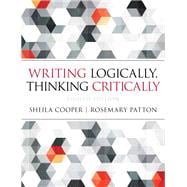Guide to Readings
Preface
Chapter 1 Thinking and Writing–A Critical Connection
Thinking Made Visible
Critical Thinking 2
An Open Mind–Examining Your World View
Hedgehogs and Foxes
Writing as a Process
Invention Strategies–Generating Ideas
The First Draft
The Time to be Critical
Audience and Purpose
E-Mail and Text Messaging
Writing Assignment 1 Considering Your Audience and Purpose
Reason, Intuition, Imagination, and Metaphor
Reasoning by Analogy
Summary
Key Terms
Chapter 2 Inference–Critical Thought
What Is an Inference?
How Reliable is an Inference?
What Is a Fact?
Reliability of Facts in a Changing World
What Is a Judgment?
Achieving a Balance Between Inference and Facts
Facts Only
Inferences Only
Writing Assignment 2 Reconstructing the Lost Tribe
Reading Critically
Making Inferences–Writing about Fiction
Writing Assignment 3 Interpreting Fiction
Making Inferences–Analyzing Images
Persuading With Visual Images
Examining Ads
Vivid Warnings
Visual Images and the Law
Summary
Key Terms
Chapter 3 The Structure of Argument
Premises and Conclusions
Distinguishing Between Premises and Conclusions
Standard Form
Writing Assignment 5 Creating a Political Handout
Ambiguous Argument Structure
Hidden Assumptions in Argument
Dangers of Hidden Assumptions
Hidden Assumptions and Standard Form
Hidden Assumptions and Audience Awareness
Summaries
Strategies For Writing a Summary
An Example of a Summary
Writing Assignment 5 Summarizing an Article
Argument and Explanation–Distinctions
Summary
Key Terms
Chapter 4 Written Argument
Focusing Your Topic
The Issue
The Question at Issue
The Thesis
Shaping a Written Argument–Rhetorical Strategies
The Introduction
The Development of Your Argument
How Many Premises Should an Argument Have?
The Conclusion
A Dialectical Approach to Argument
Addressing Counterarguments
How Much Counterargument?
Refutation and Concession
Rogerian Strategy
When There is No Other Side
Logical Connections–Coherence
Joining Words
More On Coherence
Sample Essays
A Two-Step Process for Writing a Complete Argument
Writing Assignment 6 Arguing Both Sides of an Issue
Writing Assignment 7 Taking a Stand
Summary
Key Terms
Chapter 5 The Language of Argument–Definition
Definition and Perception
Who Controls the Definitions?
Defining Ourselves
Shifting Definitions
Definition: The Social Sciences and Government
Language: An Abstract System of Symbols
The Importance of Concrete Examples
Abstractions and Evasion
Euphemism and Connotation
Definition in Written Argument
Appositives–A Strategy for Defining Terms Within the Sentence
Appositives and Argument
Punctuation of Appositives
Extended Definition
Writing Assignment 8 Composing an Argument Based on a Definition
Inventing a New Word to Fill a Need
Writing Assignment 9 Creating a New Word
Summary
Key Terms
Chapter 6 Fallacious Arguments
What Is a Fallacious Argument?
Appeal to Authority
Appeal to Fear
Appeal to Pity
Begging the Question
Double Standard
Equivocation
False Analogy
False Cause
False Dilemma
Hasty Generalization
Personal Attack
Poisoning the Well
Red Herring
Slippery Slope
Straw Man
Writing Assignment 10 Analyzing an Extended Argument
Key Terms
Chapter 7 Deductive and Inductive Argument
Key Distinction
(1) Necessity Versus Probability
(2) From General to Specific, Specific to General
The Relationship Between Induction and Deduction
Deductive Reasoning
Class Logic
Relationships Between Classes
Class Logic And The Syllogism
Hypothetical Arguments 168
The Valid Hypothetical Argument
The Invalid Hypothetical Argument
Necessary and Sufficient Conditions
Hypothetical Chains
Hypothetical Claims and Everyday Reasoning
Inductive Reasoning
Generalization
The Direction of Inductive Reasoning
Testing Inductive Generalizations
Thinking Critically About Surveys and Statistics
Writing Assignment 11 Questioning Generalizations
Writing Assignment 12 Conducting a Survey: A Collaborative Project
Summary
Key Terms
Chapter 8 The Language of Argument–Style
Parallelism
The Structure of Parallelism
Logic of the Parallel Series
Emphasizing Ideas With Parallelism
Sharpening Sentences, Eliminating Wordiness
Concrete Subjects
Active and Passive Verbs
Passive Verbs and Evasion
When the Passive is Appropriate
Consistent Sentence Subjects
Summary
Key Terms
A Quick Guide to Evaluating Sources and Integrating Research into your Own Writing
Where to Begin
Evaluating Online Sources
Checking for Bias
Three Options for Including Research
Blend Quotations and Paraphrases into Your Own Writing
Make the Purpose Clear
Punctuation and Format of Quotations
Omitting Words From a Direct Quotation–Ellipsis
Plagiarism
A Final Note
Additional Readings
“Living with Less,” Graham Hill
“The Conservative Case for Gay Marriage,” Ted Olsen
“You Are What You Speak,” Guy Deutscher
“The Order of Things,” Malcolm Gladwell
Text Credits
Index

